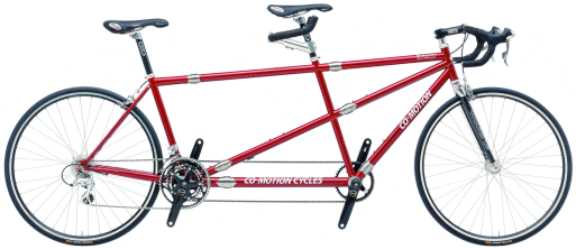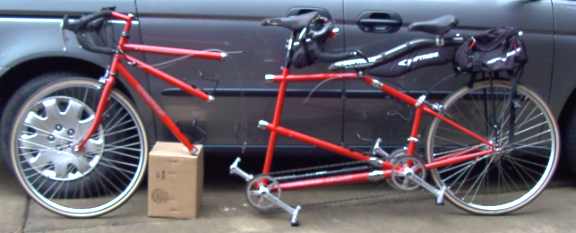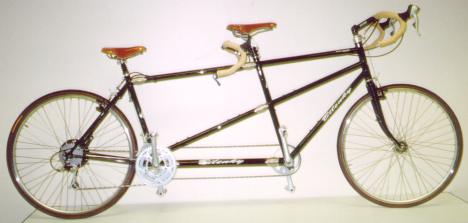
Incorporating S and S Couplings in a tandem frame
There are four common reasons for configuring a tandem frame with S and S Couplings.
AIRLINE USE TANDEMS (3 pieces): Separates the frame into 3 pieces or sections so it will fit into airline regulation size checkable luggage Probably 95% of the tandems manufactured or retrofit with S and S Couplings are configured in three sections for airline use. This method normally requires the use of 6 couplings.
NON-AIRLINE USE TANDEMS (2 pieces): Separates the frame into 2 pieces or sections so it will fit into a car, boat, train, private plane, apartment, hotel room, elevator, stairway or other confined area where a full size tandem frame wouldn't fit. This method normally requires the use of 3 couplings.
TRIPLET, QUAD, QUINT AND HEX (bikes will handle 3, 4, 5 or 6 riders) These bikes are designed to handle more than two riders and they use couplings so they can be made small enough for airline or non-airline use, depending on the customers needs. Since these bikes are so specialized, they won't be covered here. If you are interested in a three or more person bike, we recommend that you study the triplet and quad photos on our web site and then discuss your options with a builder.
CONVERTIBLE CONFIGURATIONS (variable number of riders from 1 to 6): By building a bicycle with sections that can be either added or removed, a tandem or single bike that can accommodate from one to six riders can be built. Since this technology is so specialized and complex, it won't be covered here. If you are interested in a convertible, we recommend that you study the convertible bike photos on our web site and then discuss your options with a builder.
There are two methods for positioning S and S Couplings in a tandem frame so it will fit into airline regulation size checkable luggage. Both methods result in the frame being divided into three pieces or sections. With either method, the tandem will have a front triangle, middle section and rear triangle.
The difference between the two methods is whether the couplings are placed in front of or behind the captain's seat tube.
When couplings are placed in front of the captain's seat tube, the center section is an assembly of three tubes connected by the captain's seat tube.
When the couplings are placed behind the captain's seat tube, the center section consists of 3 individual loose tubes.
With either method, coupling placement shouldn't have any impact on the riding characteristics or strength of the bike. Choosing one method over the other is a matter of personal preference with regard to use, packing and assembly. Most builders tend to use only one method although some offer both. We recommend discussing this topic with framebuilders to get their opinion. * Due to frame design, some loose tube configurations use 2 or 4 loose tubes instead of 3 but 3 tubes is the most common.
The advantages and disadvantages of the two airline use methods
Three piece tandem with couplings in front
of the captain's seat tube.
(center section is an assembly)


Shown with the front triangle removed for quick transport
(note that the timing chain is still connected)
Advantages:
Disadvantages:
Some of the builders that tend to favor this coupling placement method:
Three piece tandem with the couplings behind
the captain's seat tube (loose tubes)
(center section is 3 loose tubes)

Click here to see this
tandem packed into a single 26x26x10" hard case

Shown completely disassembled and fork removed
Advantages:
Disadvantages:
With the loose tube method, you can't make the front top tube longer than approx. 23" ctc, depending on other variables, of course. With the coupler protruding behind the top tube/seat tube intersection, the assembly becomes too large to fit into airline-checkable luggage.
Some of builders that tend to favor this coupling placement method:
There are two methods for positioning S and S Couplings in a tandem frame for non-airline use (DOES NOT FIT into an airline regulation size checkable case.) Both methods separate the tandem into 2 pieces or sections. With either method, the tandem will have a front triangle and a rear triangle although they may be unequal in size depending on the placement of the couplings.
Some people split their tandem in 2 sections like this then pack it into a conventional single bike case which does not meet the airlines standard for checkable luggage. Although they may end up paying fees to the airlines, they still end up with a case that is more manageable than a full size tandem case. The cost for adding only half as many couplings is also a lot less.
The difference between the two methods is whether the couplings are placed in front of or behind the captain's seat tube.
With a split in front of the captain's seat tube, the rear triangle is large and the front triangle is small.
With a split behind the captain's seat tube, the frame halves usually results in two more equal sized pieces.
With either method, coupling placement shouldn't have any impact on the riding characteristics or strength of the bike. Choosing one method over the other is a matter of personal preference with regard to use and packing requirements.
The advantages and disadvantages of the two non-airline use (2 piece) methods
A split only in front of the captain's seat tube
Advantages:
- Very fast and easy to remove the front triangle since the timing chain doesn't have to come off. This feature is also the same on the 3 section tandem that is split in front of the captain's seat tube. Here are some photos of a tandem with the front triangle removed for train travel.
Disadvantages:
- The rear triangle is much larger than the front triangle so it doesn't pack in as small a case.
- The lower coupling is only accessible from one side due to the closeness of front chainring.
- Only the rear half can be locked so a thief could undo the couplings and steal the front half of the bike (as far as we know, this has never happened).
Links to some bikes with this configuration:
A split only behind the captain's seat tube
Advantages:
- The size of the two pieces can be equal so it can be packed into a smaller case than the other method.
- The lower coupling is accessible from either side since there is no chainring close to it.
- Both the front and rear halves of the frame can be locked, even if the couplings are opened.
Disadvantages:
- The timing chain needs to be removed when the tandem is taken apart which can be a dirty job.
Links to some bikes with this configuration:
Framebuilder list | Cases | Packing | Photos | Reviews | Comments | Retailer list | Installation | Specifications | Cost | Retrofit or new? | Travel adventures